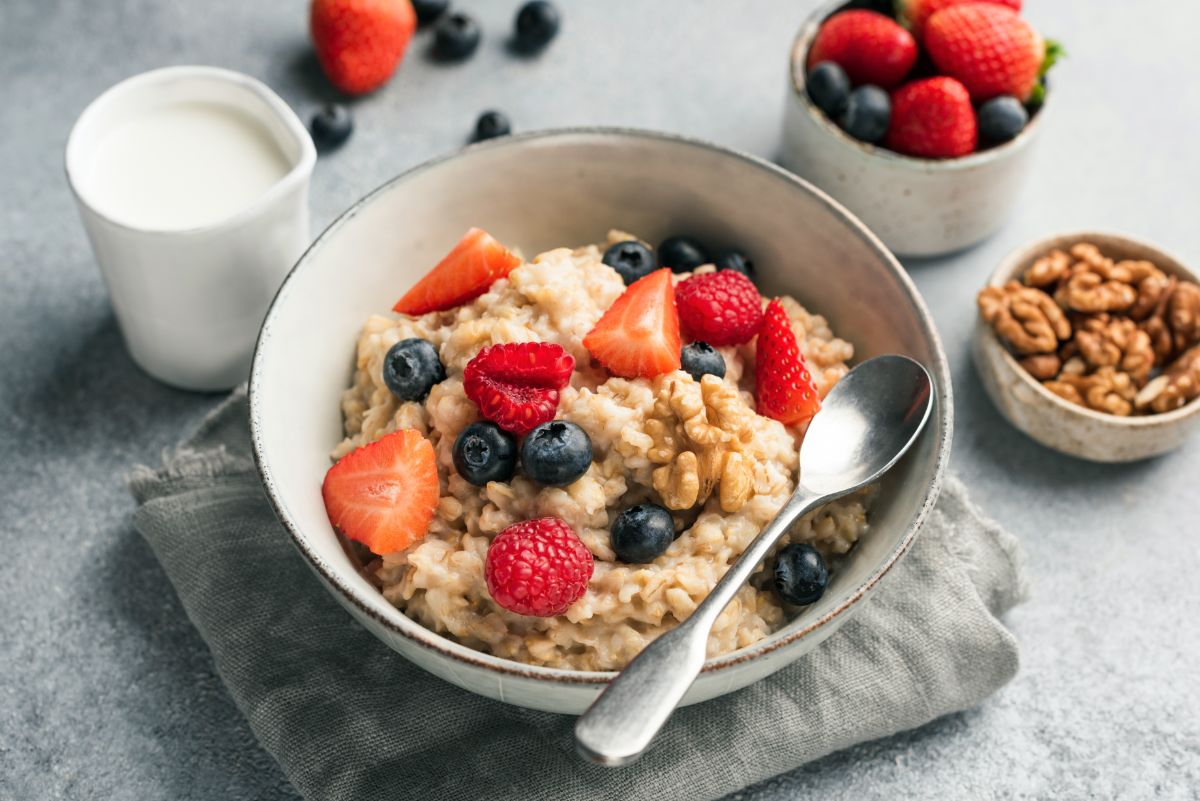Truth be told: your energy levels are measured by what you eat in the morning. A healthy breakfast should meet your nutrient requirements, and most importantly fit within your calorie budget.
A typical American breakfast consists of a cereal-based dish like oatmeal or bagels. So which one is a healthier option? Let’s find out.
The nutritional profile of bagels

Bagels are made from wheat flour, yeast, salt, and water. You can also add additional ingredients like herbs, dried fruits, spices, and sugar.
Depending on the size, a bagel can give 40-75 grams of carbohydrate which helps to boost your energy levels. A multi-grain bagel provides 6 grams of fiber which has a positive effect on blood sugar levels. It’s unlikely that you’ll experience an energy crash after you eat a whole-grain bagel.
Also, bagels are rich in protein depending on the method of preparation. A typical egg gives 11 grams of protein while a cup of milk gives 10 grams of protein.
When it comes to the number of calories, you should consider the vast range of bagels to choose from. A single-sized bagel in your local bakery contains 1.5 grams of fat and about 300 calories.
The larger ones can give up to 600 calories. This can be compared to eating 5-6 slices of bread. Keep in mind that calories don’t necessarily come with nutritional benefits. Plain bagels don’t contain fiber and other nutrients which makes them empty calories.
If the bagel contains regular cream and fat, you can end up with a 2000-calories diet. The flavor you choose will also affect the calories count.
For example, a French toast bagel has more calories than a poppy seed bagel. And finally, one ounce of fortified bagel provides the body with 1.7mg of iron which is about 9% of the required daily intake. Other essential minerals include folate, thiamin, and riboflavin.
*This article may contain affiliate links. As an Amazon Associate, I earn from qualifying purchases. Please take that into account.
- Dutch oven
- Large mixing bowl
- Measuring cups and spoons
- Bread thermometer (fancy or a budget one)
- Scoring lame
Extra (nice to have):
- Kitchen scale
- Dough scraper and bowl scraper (yes, they are different)
- Cooling rack
- Baking stone (you don’t need a dutch oven if you use this)
👉Learn how to make bread and pizza with this awesome book.
The nutritional profile of oatmeal

We can’t deny the fact that oats are some of the healthiest grains on earth. A bowl of oatmeal is gluten-free and delicious. It helps to control blood sugar and reduces the risk of heart disease.
Oatmeal is rich in fiber which aids the breakdown of sugars in the body. One cup of oatmeal contains 8 grams of dietary fiber. This means that it’s easier to reach the daily requirement.
Additionally, one serving of oatmeal contains about 6 grams of protein and 150 calories. There are also trace minerals like magnesium, iron, manganese, phosphorus, and zinc.
Which Is Healthier Bagel Or Oatmeal?
Oatmeal is a healthier alternative because it contains less fat. Other than that, it has more fiber than bagel which is beneficial to the digestive system.
And because half the fiber is soluble, it functions with the help of water. The remaining fiber is insoluble. Oatmeal sweeps out every nook and cranny out of the bowels.
This minimizes strain when you use a restroom. Be sure to eat a small portion as too much fiber can cause bloating, gas, and other abdominal problems. Of course, you must drink lots of water to keep the digestive tract moist and lubricated.
Oatmeal can play an important role in your cholesterol levels. The soluble fiber has a dramatic effect on LDL cholesterol.
Generally, you should take 5-10 grams of fiber a day to eliminate the bad cholesterol. The fibers in oatmeal bind the molecules and carry them out of the body.
While bagels can also help in maintaining the right cholesterol, oatmeal is more effective. A study conducted by the Mayo Clinic showed that taking a bowl of oatmeal in the morning can lower cholesterol levels by 40%.
Oatmeal is rich in antioxidants which help to eliminate the free radicals that cause illnesses. It contains polyphenols which improve blood flow. Preliminary studies show that oatmeal can prevent heart disease, cancer, blood pressure, and more.
Oatmeal is gluten-free so it can be consumed by people with gluten-intolerance. Always read the labels properly before you make your purchase.
Stick to the brands labeled gluten-free as cross-contamination can occur in the fields where wheat is present. Most of the bagels out there contain gluten which can be detrimental to patients with celiac disease.
In terms of weight control, oatmeal is a better alternative than bagels. Because of the high fiber content, they make you feel fuller for longer.
This prevents unhealthy snacking which can help you achieve your weight loss goals. If you have to take bagels, you should keep the portion under control. Lastly, oatmeal reduces the risk of childhood asthma. It’s one of the healthiest meals a child can ever eat.
How to make your bagel healthier
The first cautionary measure is to avoid a refined bagel. Refining removes vitamins, minerals, and dietary fiber. Make sure you prepare your bagel with whole grains.
This makes it rich in fiber and provides more calories. If you want to add toppings, go for healthy veggies and other fresh ingredients. Avoid butter and high-calories cheese.
Thirdly, watch out for added sugar. Prepare your bagel without added sweetener. The portion is also very important. You should opt for smaller bagels or stick to a half.
A smart way to save on calories is `hollowing out’. If you don’t want to make any modifications, one bagel won’t destroy your healthy diet.
When the bagel at the store says multi-grain, this means that there’s more than one grain. Whole wheat bagel contains 49 grams of carbohydrates, 11 grams of protein, and 250 calories.
You should put more emphasis on protein and fiber content rather than the calories. A bagel is a wholesome choice if you want to keep the excess weight at bay.
How to make your oatmeal healthier
If you’re trying to lose weight, oatmeal should be part of your everyday breakfast. Make sure you eat wholegrain oats as sugar-laden packets can turn your breakfast into a nightmare.
To increase the protein content when preparing your oatmeal, you should add one tbsp. of peanut butter or a half cup of yogurt. While rolled oats will take longer to cook, they contain more fiber.
A half-cup serving supplies the body with 7 grams of dietary fiber. You should also reduce the amount of sugar. Instead of using white sugar, you can use honey. You may also want to sprinkle some flaxseeds to get your fill of omega 3s.
Final words
Oatmeal is a better source of carbohydrates, dietary fiber, and makes you fuller for longer. If you want to make bagels part of your morning routine, you should mix with other foods rich in fiber and protein.
This will ensure the eating plan is on track. You can also serve with a glass of milk, fresh fruits, or yogurt.
